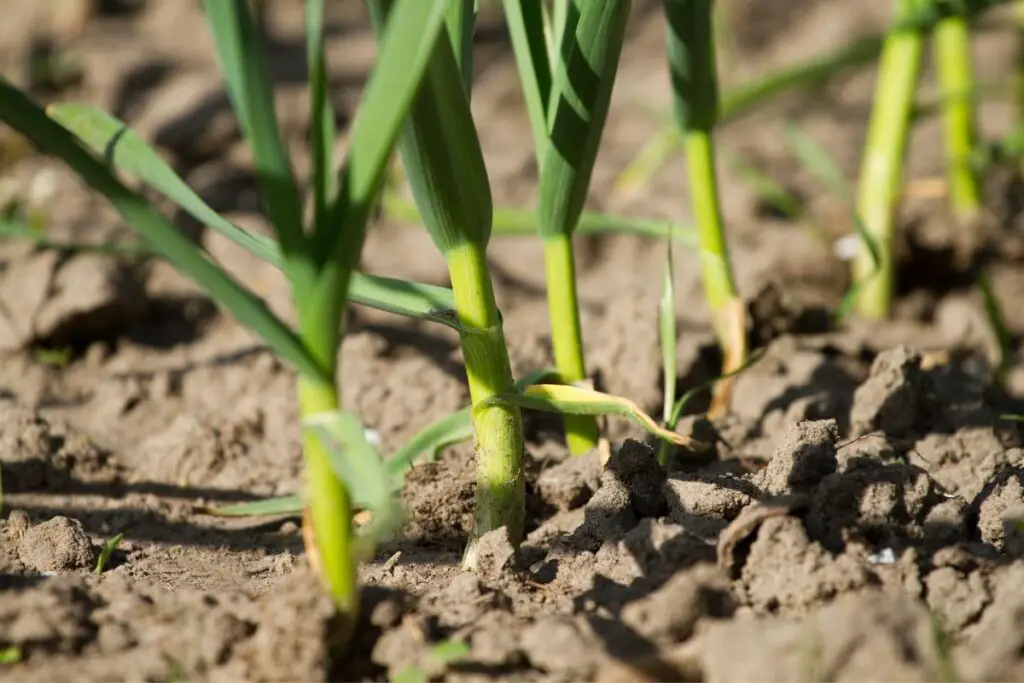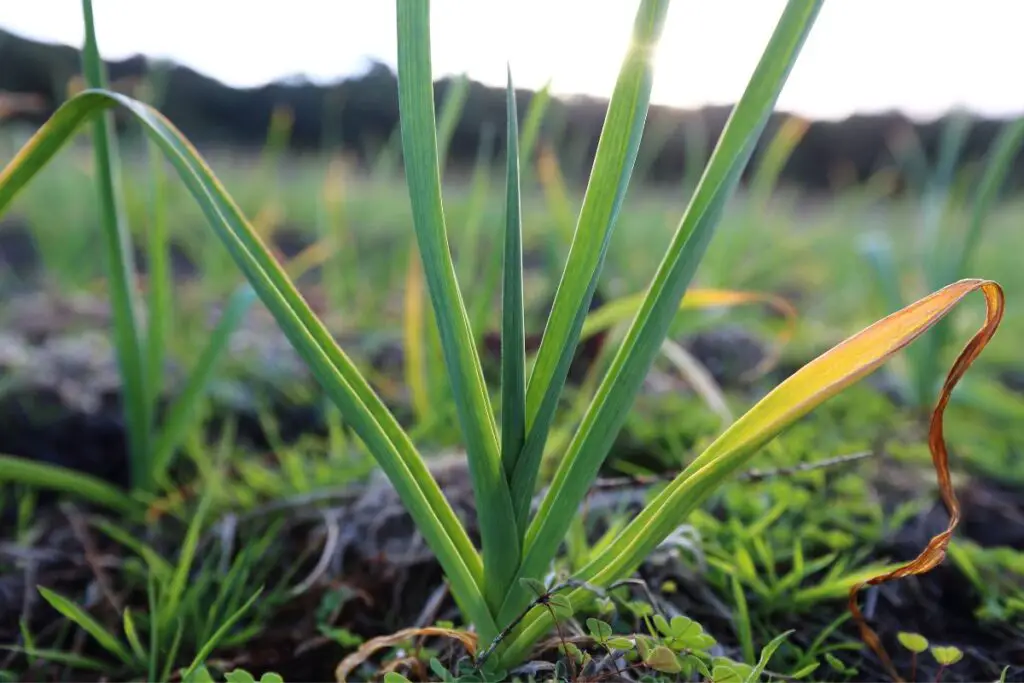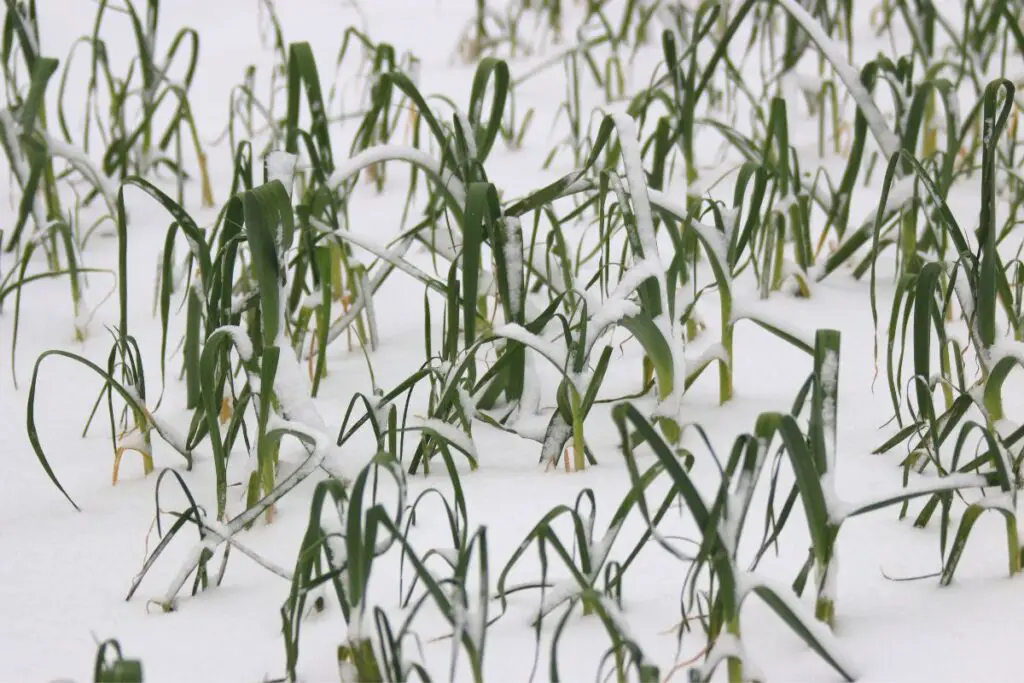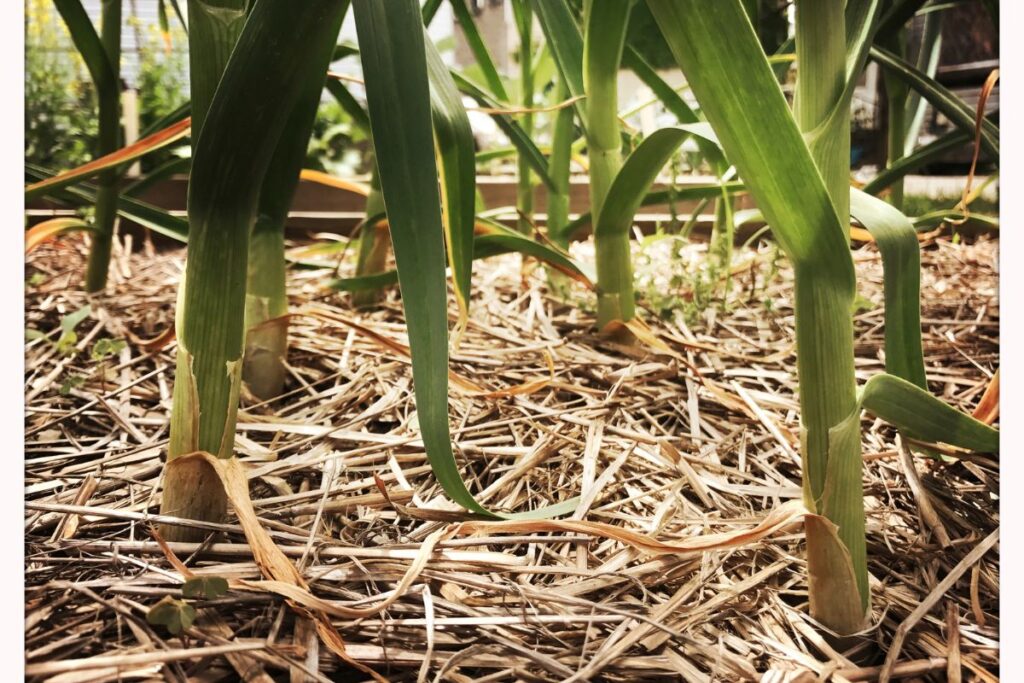Growing garlic plants successfully in your garden is satisfying because you get fresh garlic without having to buy them. But, you should know the temperature of the area since it plays an important role in determining the successful growth of the garlic.
In general, garlic grows best when they receive a temperature range between 32-50°F for the first 2-3 months. Though garlic can tolerate a wide range of temperatures once roots develop, extreme temperatures are not good for them, especially at the early stage of growth.
Too cold or too hot can have negative effects on garlic plants. This guide will help you know the ideal temperature for garlic and how to deal with garlic during extreme temperatures.

What is the ideal temperature for garlic?
Generally, garlic plants enjoy cool weather for vigorous growth, but they also need heat for bulb development.
After planting, the ideal temperature required for garlic is between 32°F and 50°F for the first two months.
This temperature helps the cloves in the vernalization process for which the bulb growth gets triggered.
The garlic cloves can get this temperature range in the winters.
But, if you belong to regions with milder winters, the bulbs can’t receive these temperatures.
In that case, you need to refrigerate your cloves for 6-10 weeks before planting.
For refrigerating, the cloves will require a temperature of about 40-50°F.
After the roots become strong, garlic can tolerate a wide range of cold and hot temperatures.
Garlic grows best when the air temperature remains about 68-70°F, and the soil temperature is about 60°F.
Despite the garlic plants’ tolerance to extreme temperatures, there are some limitations.
After all, no plant can tolerate temperatures after one level.
The ideal temperature for garlic in winter is around 30-50°F, and in summers, it is up to 70-80°F.
Though garlic can tolerate temperatures lower than 20°F, it won’t be able to handle temperatures beyond 80°F.
How hot is too hot for garlic plants?
Garlic is generally a cold-hardy plant.
It can endure cold temperatures to a great extent, but it won’t be able to tolerate excessive heat.
But, on the contrary, some varieties are excellent heat-tolerant varieties.
Garlic is divided into two groups – Hardneck variety and Softneck variety.
As the name says, Hardneck has hard necks and is also hardy in colder zones.
Softneck varieties, on the other hand, are ideal for the warmer zones.
These varieties are more tolerant of heat temperatures than the Hardneck varieties.
So, if you live in warmer zones where temperatures are hot enough, you can grow the Softneck varieties.
What happens if garlic is exposed to extremely high temperatures?

Remember that all the varieties can endure up to 70-80°F.
If your region receives excessive hot summers where temperatures rise above 90-95°F, garlic will stop growing.
As I mentioned, once the cloves develop roots, they can tolerate the hot weather greatly.
But, there is an endurance limit.
Temperatures around 90-95°F will stunt the growth of garlic.
Garlic will mature early at such high temperatures, and harvest time will arrive sooner.
The sad part here is you will not get the ideal bulb sizes.
They will be smaller than your expectations.
The garlic cloves will require vernalization for 40 days.
If the temperature rises above 90-95°F, which is quite common during the summer in warmer regions, the cloves can de-vernalize.
If de-vernalization occurs, you will receive smaller bulbs.
Looking for gardening supplies? We have tested 100's of products before recommending them to you guys. Check out our best pick below:
| Image | Gardening Supplies | Best Price? |
|---|---|---|
 Top
Top Top
Top | Raised Garden Bed Kit | Check On Amazon |
 | XLUX Soil Moisture Meter, Plant Water Monitor, Soil Hygrometer Sensor for Gardening, Farming, Indoor and Outdoor Plants, No Batteries Required | No Results |
 Top
Top Top
Top | 82 Pcs Garden Tools Set and Extra Succulent Tools Set | Check On Amazon |
 | Joeys Garden Expandable Garden Hose with 8 Function Hose Nozzle, Lightweight Anti-Kink Flexible Garden Hoses, Extra Strength Fabric with Double Latex Core, (50 FT, Black) | No Results |
 Top
Top Top
Top | Dual Chamber Compost Tumbler | Check On Amazon |
 Top
Top Top
Top | Sunnyglade Plant Stakes | Check On Amazon |
 Top
Top Top
Top | Organic Cold Pressed Neem Seed Oil | Check On Amazon |
 Top
Top Top
Top | Mighty Mint Gallon :-Insect and Pest Control Peppermint Oil | Check On Amazon |
 Top
Top Top
Top | Scotts DiseaseEx Lawn Fungicide | Check On Amazon |
 Top
Top Top
Top | Jacks Classic 20-20-20 All Purpose Fertilizer | Check On Amazon |
 Top
Top Top
Top | 30,000 Seeds Pollinator Attracting Wildflower Mixture | Check On Amazon |
 Top
Top Top
Top | Survival Vegetable Seeds Garden Kit-Over 16,000 Seeds | Check On Amazon |
What should I do if the temperature gets too hot?
If you wish to grow garlic in the warmer regions, you should let the cloves have proper vernalization and let your plant grow bigger with lots of leaves.
Sometimes, it is better to choose the garlic varieties that can tolerate such amounts of hot temperatures.
Softneck varieties are perfect for areas with warmer climates.
They can tolerate more heat than the other variety.
Besides, Softneck varieties don’t require a very hard cold for vernalization.
A cold temperature of around 50°F for 30-40 days is enough.
Plant the garlic 4 weeks before the ground freezes so the cloves can receive the winter cold for vernalizing.
To complete the vernalization process, you can give the garlic cloves this cold treatment by storing them in the refrigerator for 8-12 weeks before planting.
No matter how bad higher temperatures are for garlic, it would be best not to plant them in the shade.
Even if the sun’s heat is too much, you should always plant the garlic cloves in a sunny location.
To keep them cool from extreme heat, you should water them well to maintain consistently moist soil.
Should I grow garlic in warmer climates?
The first best time for planting garlic is fall.
If you have missed it, the next preference is early spring.
If you have missed both, you can still plant garlic in the summer only if your living areas receive cool summers and mild winters.
If planted in late summer, the cloves can overwinter and continue growing in the spring.
You can try green garlic if your area has a shorter growth period.
This garlic matures faster and can only be harvested in 2-3 months.
Also read: When To Plant Garlic Bulbs? (+Seasonal Guide)
How cold is too cold for the garlic plants?

Garlic has an excellent endurance level for cold weather.
It can tolerate cold temperatures as close as -20°F to -30°F.
The Hardneck varieties have a higher tolerance level for cold than the Softneck varieties.
They can be easily grown in zones 2-9, where the minimum temperatures are -40°F.
Softneck varieties are better for warmer zones but can also tolerate cold temperatures around -20°F.
Garlic requires a long cold temperature of around 30-40°F for at least 40 days for vernalization. So they can grow efficiently in cold weather.
Some Softneck varieties like Sicilian are native to zones 8-10 and can tolerate temperatures around 10-15°F.
California Early and Late can tolerate around 0 to -5°F without damage.
What happens if garlic receives excessive cold weather?
But, excessive cold is not good for garlic. Garlic cloves generally don’t suffer much from cold injury unless you don’t cover them with mulch.
The ground can freeze too much if the weather is very cold and frosty.
The soil gets displaced around the tender roots of the cloves.
The frost harms them, thus resulting in no plant growth.
At 5°F, the small, recently developed garlic heads will die.
If temperatures drop to 12°F or below, even the well-established garlic heads will die.
The garlic tops that have received frost will yield less than those that have not yet received frost.
But, don’t worry, because the heads will grow back once the temperature rises above 40°F.
During the winter, a condition occurs called frost heave, where the temperature fluctuates greatly.
One day, the weather is frosty, and the other day, it’s warm like summer.
These fluctuations crack the soil around the tender roots and tear them, resulting in stunted growth.
What can I do if the weather gets too cold?
If your area receives mild winters, you can easily plant garlic cloves and grow them without issues.
But if your region gets cold enough, you should not forget to mulch the cloves.
The mulch should be at least 6 inches thick.
The mulch will stop the cold from reaching the roots.
It also allows the hot weather to reach the roots during the frost heave.
As a result, the bulbs won’t start growing in the cold, which is good.
If your area receives extreme cold and frost, you should plant the garlic cloves at least 4-6 inches deep so that the frost cannot reach the tender roots and damage them.
Also read: Will Garlic Survive Frost? (+Protect Garlic From Cold Weather)
How to overwinter garlic?

Here are some simple steps to grow and overwinter garlic:
- Plant your garlic in the fall, so it gets time to grow roots, and then the winter season for bulb development.
- After planting and watering the bed, cover the cloves with mulch like straw, sawdust, leaves, or grass clippings.
- Let them overwinter.
- Avoid wearing and fertilizing your garlic cloves. Since it will become dormant when the ground freezes, it won’t absorb any of it.
- Add another 4-6 inches of mulch to prevent the spring weeds when the snow melts in spring. For covering the garlic cloves, you can use:
Agrofiber: It is a polypropylene film that doesn’t accumulate moisture and freeze garlic and gives the cloves sufficient light.
Fallen leaves: These are easily available and work great as mulch. But, the leaves might get infested by bugs and fungi we are unaware of.
Plant stems: Only stems are used to cover the plant. It can hold the snow and prevent the soil from getting damp when the snow melts.
Peat: It is a great insulator and saves the cloves from extreme frost. Peat also traps moisture, so avoiding watering won’t bother the cloves.
Sawdust: It is a good thermal insulator that absorbs and retains moisture greatly. But it is not as strong as others.
Can I grow garlic in cold areas?
If you belong to areas where the temperature doesn’t drop below 40-45°F, you can plant garlic in winter.
If winters are too mild, you need to vernalize the seeds or cloves in the refrigerator for a few weeks and then plant.
Plant the garlic 3-4 weeks before the first frost.
It won’t let the garlic sprout out until the cold weather passes.
Don’t forget to cover the cloves with a thick layer of mulch.
Final thoughts
The ideal temperature for garlic is 30-50°F for the first two months after planting. Then, the ideal air temperature for the plant’s and bulbs’ vigorous growth is 70°F. The ideal soil temperature is around 60°F.
Though garlic requires sun heat for growing, it will stop growing if the temperature rises above 90-95°F. Water the plant to keep them cool but don’t cover them.
If you live in the warmer areas, it is better to grow Softneck varieties as they can tolerate enough heat and require less vernalization.
Garlic is an excellent cold-tolerant plant (-30°F), but excessive frost can harm the cloves and roots if you don’t mulch them. In some cases, garlic heads die.
So, don’t forget to mulch your garlic cloves after planting. Avoid watering and fertilizing. If you live in areas with warm winters, you do not have to cover them much.
Reference: The Pennsylvania State University, Garlic Production for the Gardener, University of Massachusetts Amherst, Ohio State University Extension.
